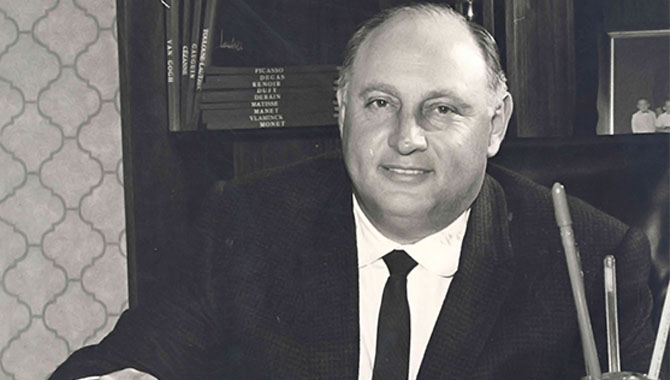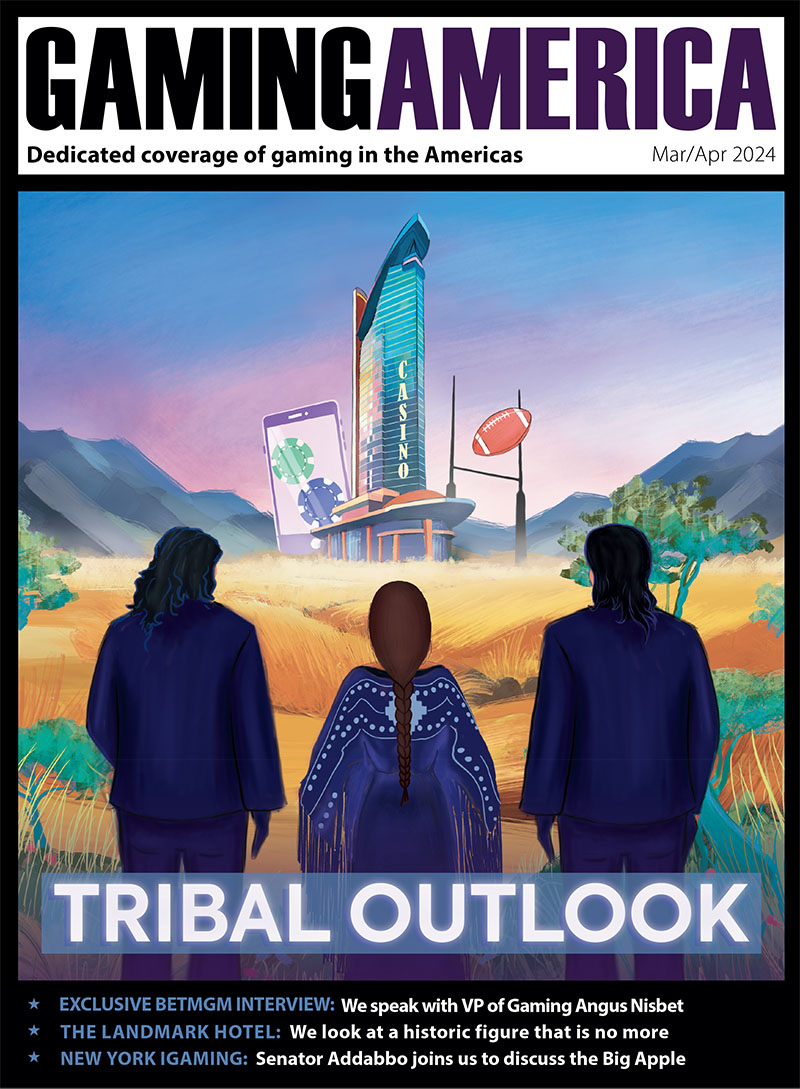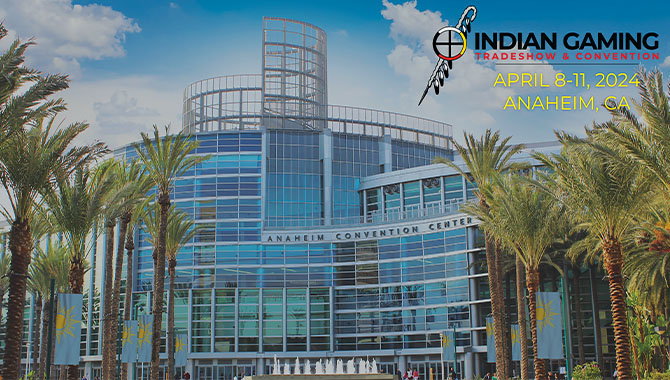
Like many great innovators whose work is only truly recognized with the passing of time, Jay Sarno, the mastermind of both Caesars Palace and Circus Circus, has developed legendary status in Las Vegas. He was revered by both those who knew and worked with him, and admired by generations of others who did not, all recognizing his genius in understanding the psychology of the customer experience and translating that into a philosophy for hospitality design.
Moreover, his influence was wider. Without Sarno, it is highly unlikely MGM’s Kirk Kerkorian would have had the confidence to scale his business, unlikely Bill Bennett would have had the canvas to inspire his Mandalay Bay Resorts portfolio and unlikely Steve Wynn would be able to build The Mirage, Bellagio and Wynn. There is no doubt that Las Vegas would not be the city it is today. In 2024, 40 years after his passing, we assess Jay Sarno’s legacy and extract the truths learned from a remarkable life and his relevance today.Jay Sarno
In possibly the best book written about Las Vegas’ history, “Grandissimo. The First Emperor of Las Vegas. How Jay Sarno Won A Casino Empire, Lost It, And Inspired Modern Las Vegas,” David Schwartz chronicled Jay Sarno’s 62 years on the planet. It could have been several volumes.
The son of Polish immigrants, Sarno was born in Missouri in 1922. From humble beginnings, he studied Business at The University of Missouri, where he met his future business partner Stanley Mallin. Like a real estate Laurel and Hardy, Sarno’s exuberance was balanced by Mallin’s level-headedness, focusing on the numbers and structure. After serving together in the US army, Sarno and Mallin embarked on a tiling business, before taking advantage of the growing interstate network, generous Federal loan scheme and Teamster finance to open the Atlanta Cabana Motor Hotel in 1958, Palo Alto Cabana in 1962 and Dallas Cabana in 1963.
In what was a unique fusion of European classic and Miami modernism, Sarno’s designs blended visuals of consumable cinematography with the aspiration of the post-war customer. Amplifying the relatively low-cost build to seem spectacular, the Cabanas evolved to feature the distinctive Sarno block design, with a Tiffany green illumination and bold lighting to create a sense of place, visible from a distance.
Their properties were set out like an open buffet; the aperitif of fountains and statues led to the curved cornucopia of lounges, restaurants and pleasure points for guests to enjoy. Sarno saw more than function; there was a psychological element to the places he created.
During his building spree, Sarno was drawn by the dice to Las Vegas. His initial impressions were that the town’s resorts lacked the elegance of Miami and his own properties. The resorts were formulaic; The Sands, Dunes, Sahara, Desert Inn, Riviera and Tropicana, in various shapes, all offered the same: a casino, hotel, entertainment and generic restaurant offerings. The entertainers on the marquees outside were often billed more prominently than the resorts that hosted them. But despite this, they were making good money and, with a casino, significantly more than was possible in a traditional hotel.
Sarno moved to Las Vegas in 1962 to conceive and oversee the development of his proposed Cabana Palace, on land owned by future MGM Resorts founder Kirk Kerkorian, where the aborted Martinique Resort was once to be built. The success of his Cabana properties gave confidence to Teamsters to finance much of the project. Although the name Hadrian’s Villa was mooted, the duo settled on “Caesars Palace” and, on August 5 1966, Las Vegas was changed forever, bringing aspiration, fantasy and escape into the casino experience.
Sean McBurney, Regional President of Caesars Entertainment, who has had oversight of Caesars Palace for several years, observed, “Luxury resorts in Las Vegas started with Caesars Palace, thanks to Jay Sarno. However, he thought of luxury differently. He wanted it to be accessible to everyone. It was his fundamental vision that “everyone is a Caesar,” which, of course, explains why there is no apostrophe in our name.
“The notion of 'luxury for everyone' continues at the property to this day and it’s why it experiences such extraordinary levels of visitation. Caesars Palace is luxurious in ways that appeal to the wealthiest and most powerful in the world, but it’s an approachable luxury that feels attainable to many more visitors. Caesars Palace has a special energy. It’s steeped in fun and celebrates luxury in myriad ways and at various scales, ensuring that anyone who walks through our doors can feel just as Jay envisioned – like a Caesar.”
Yes, the established template of casino, hotel, entertainment and restaurant were all present, like Sarno’s past projects they were on full display. Within Caesars Palace sat a fully immersive Greco-Roman theme, which was pervasive throughout the property. Outside, this property was architecturally different, owing more to both the Cabana Motor Hotels and Miami’s Fontainebleau than anything already on the market. Indeed, among the fountains and cypress trees, the Caesars Palace-branded signage dominated whoever was playing at the Circus Maximus showroom that evening.
Rather than the norm, where elements of the resort were in separate buildings, Caesars Palace was a casino-centric wheel, where the energy generated on the casino floor permeated throughout the building. Having the casino at the center of the action was to be highly influential to all subsequent casino designs. Before his passing in 2021, Mallin said, “Sarno was a genius. At Caesars Palace, we captured lightning in a bottle. We just wanted to be the best in town. All our energies were spent on raising money and, in one respect, that was our failure as the only place we could get staff was from other hotels in town. If we had spent more time on management, we would have avoided the problems we had later.” This was not to be the first time this problem arose.
The cost to build Caesars Palace has been reported at anything between $12-24m, but after just three years and with federal eyes taking interest in the casino management division run by alleged mob associate Jerry Zarowitz, Sarno and Mallin sold the property to Lum’s for $60m. This left the duo to concentrate on their other venture, one that some believe to be even more radical than anything that had come either before or has come since.
What was originally conceived as Caesars Desert Palace, opening on April 27 1968 on the site where The Mirage now stands, Sarno’s second Las Vegas resort became Circus Circus, housed in a Homer Rissman designed faux-Circus tent. Kerkorian was an investor. Although actor Clarence Hoffman was hired as the official ringmaster, all eyes were on Sarno. The casino opened without a hotel, without headliner performers and charged for entry. Inside was a highly immersive, experiential design, hued with color, fantasy and spectacular.
Commercially, it operated double the bars and restaurants of Caesars Palace and four times the slot machines, busting the established tables-to-slots ratio, changing the casino floor. Of course, there was entertainment, with the circus performers as a pervasive theme throughout. The hotel finally opened in 1972.
Before the hotel’s guestrooms, Circus Circus was operationally challenged, with duo Bill Bennett and Bill Pennington assuming operations in 1974, bringing discipline to proceedings, far away from the unstructured creativity and imagination of its principal visionary. The property became highly successful after Sarno stepped aside from running it. He remained a shareholder until 1983.
Sarno spent the following years fighting (and being acquitted) of further charges that caused him and Mallin casino licensing difficulties, investing in and operating other businesses, including karting, Slots-A-Fun and the Big Wheel Casino site of the Bonanza Gift Shop on the Sahara Strip intersection. But whether it was his past relationship with Teamsters, historic tax and licensing challenges, his lively personal life or the economic conditions of the late 1970s and early '80s, there was to be no completion to Sarno’s final project.
Sarno died in 1984. His sale of Circus Circus stock had awarded him over $70m, but his never realized masterpiece, Grandissimo, was to have a significant impact on the future of Las Vegas. A 6,000 room, multi-tower casino resort was fantasy to many, especially as the largest properties at that time were under a quarter of that size; but once again Sarno demonstrated his remarkable prescience; Grandissimo was the template for the megaresorts that would come to dominate the city. As every new resort opens, today’s Las Vegas is closer to Sarno’s vision of what the city was to become than anyone could have imagined during his lifetime.
Paul Steelman, the architect behind notable casinos on multiple continents observed, “Jay Sarno left an indelible mark on the city’s landscape and the casino industry. His innovative thinking set a precedent for extravagant and immersive entertainment experiences. Sarno’s crowning vision, Grandissimo, was ahead of its time, with the potential to reshape the very fabric of Las Vegas. Moreover, Sarno’s visionary approach could have expanded the Las Vegas entertainment district beyond the iconic Strip, encompassing both sides of Interstate 15, transforming the city into an even more colossal playground for visitors and redefining the skyline of Las Vegas for generations to come. The untapped potential of Grandissimo serves as a testament to Jay Sarno’s enduring influence on the evolution of Las Vegas as a global entertainment hub.”Learning from Sarno
Why is it, 40 years after his death, that Sarno’s legacy grows with every passing year? Resort development is vastly different today than when Jay Sarno came to town. Then, organized crime was involved across the city, segregation was a fresh memory (Caesars Palace was the first property on The Strip to hire front-line black employees) and the town was predominantly a gambling hub.
Throughout his time in Las Vegas, there were many operators and big personalities and Sarno was not alone in shaping the casino industry. But there is no doubt to those who chronicle the development of the city that he was its principal innovator. In the '60s and '70s, Sarno was often found in deep conversation with industry leaders past, present and future, at breakfast at Caesars’ Noshorium, lunch at The Riviera coffee shop, dinner at Bob Taylor’s Ranch or on Sunday night at The Las Vegas Country Club. Occasionally he would head to his favorite, Wendy’s, for a sneaky burger.
It is also true that alongside his creativity and larger-than-life character, Sarno lived life to the fullest, indulging in all of life’s pleasures, with idiosyncratic exuberance. Alan Feldman, the longstanding executive who played a role in opening many of Las Vegas’ resorts, including The Mirage, Bellagio and Aria, is one of those keen students of Las Vegas’ history.
“It’s been said that there are three vices that can ruin someone’s reputation: gambling, womanizing and drinking. An industry colleague once told me that in Vegas, you might survive if only two were present in your life. Jay Sarno was a man who knew no excess in anything he did. Unfortunately, the same magnificent places and experiences he created for guests were perfect environments for his own weaknesses to flourish. Even so, in the end, his concept for Grandissimo is startlingly prescient.”
Later in his life, Sarno was invited to guest lecture at UNLV, where he spoke about his thoughts and experiences in the casino world, inspiring the lucky few that were present at these sessions. For those of us that work in this space today, we understand that few (if any) have held the raw intuition of Sarno. His name frequently arises when discussing new projects or designs, which is why we look to his work to find inspiration to better ours. Without a notebook or recorded interview, our only guide to understand Sarno’s thinking is to reflect, deconstruct, extrapolate and emulate. Set the tone
Heidi Sarno Straus observed her father’s secret; he knew people. He was hardwired with an innate understanding of customer psychology, from growing up in poverty dreaming big, from his time in the army where he was the guy that kept things together and from his time in developing motels. He knew resorts weren’t about functional real estate, they were about people. He created an offering with customer centrality; how do you want people to “feel” in our hotel?
This view is shared by Feldman. “He was the first person to understand the motivations that drive customer decisions and he did it entirely on instinct. No polling or focus groups were needed for Sarno. He felt it in his heart and he was exactly right. He was the person who gave Las Vegas its identity beyond being a dusty rough-and-tumble gambling town. He didn’t do this with articulate definitions or strategies. He didn’t do this as an academic exercise. He was one of the most intuitive people to ever call Las Vegas home.”
From the second that the customer saw one of Jay Sarno’s twinkling properties in the distance, the customer knew this was a different place from other hotels. Sarno would take the customer on a journey, from the first impression to the entire experience.Decades later, Roger Thomas, who designed many of Steve Wynn’s interiors, codified resort theming as “evoca-tecture.” Wynn’s properties were like Sarno’s – resorts that were not designed as replicas, but to evoke the feeling as if you were in Rome. The Mirage suggested a tropical vacation and all the elegance of Lombardy was to be found at The Bellagio. With Caesars Palace, the theme and design were all about indulgence, fantasy, elegance and aspiration. And most importantly, escape from normality.Ask, why?
One of the most enduring and compelling legacies of Jay Sarno was his challenging of the norm. McBurney commented, “Caesars Palace was innovative when it opened in 1966 and, over the last 57 years, it has continued to pioneer firsts. Staying on the path Jay charted, Caesars Palace is largely responsible for shaping how the market looks today. The first luxury shopping mall (Forum Shops), the first celebrity chef, the first mega-nightclub and the first resident headliner all started at Caesars Palace. Today, all those elements are pervasive throughout the market. In a testament to his legacy and the spirit of Las Vegas, these lessons of innovation and leading the market guide how we operate today.”
Sarno’s constant challenging led to mistakes, but he wasn’t afraid to make them. The entrance to Circus Circus was reconfigured just days after opening at great cost to a new property. He opened that casino without a hotel. Big mistake.Legendary casino manager Burton Cohen said working for Sarno, “Was [one] of the greatest experiences of my career, Jay was a visionary. Las Vegas was the only place that could overcome Jay’s ideas. He was very innovative. He would ask why? Just because they always did it that way it doesn’t mean that we continue to do it that way.”
It wasn’t to be the last time that the front of a new casino was configured shortly after opening, but the best developers and operators continue to heed Sarno’s lesson that real innovation begins by asking why.Recruit the best
Decades before future Caesars Palace operator, Gary Loveman, was researching the importance of front-line interactions at Harvard University, Sarno was empowering his staff to engage with customers. Conversations, improvisation and approachability were all necessary to work at his properties, knowing intuitively that loyalty and repeat business was based on positive experiences; if you had a great experience at one of his properties, you would be back. Hiring the right people was vital to achieving this.
At an executive level, Sarno partnered with architect Melvin Grossman and interior designer Shirley Joan “Jo” Harris, both of whom interpretated Sarno’s grandiose ideas into the practical, with Harris in particular aligning contemporary elegance to many of Sarno’s concepts. Nat Hart, hired as the Maître d’ of The Bacchanal Room, grew to become the original “Celebrity Chef” and one of the most important executives in Food and Beverage in the history of the city, opening dozens of restaurants and authoring many of the handbooks that are the basis of what isused today.
There is no doubt that Sarno’s creativity and experimental instinct knew no limits, but his budget frequently did and it was left to Mallin, Cohen and other trusted executives to draw the line on what was and was not feasible. Having people that say no is as important as those that don’t, recalled Cohen in his dealings with Sarno. However, Cohen didn’t win in every case, as legendary tales of Tanya the elephant, who joined the Circus Circus repertoire from the Dunes, will testify.Next?
Jay Sarno was a man on a mission – he was always looking for action. He had one speed: fast. His energy was contagious and his demands were great. He was a straight talker with little time for stupidity. For Sarno, money wasn’t important, his passion was his projects and the pursuit of pleasure. He was never satisfied, always wanting more and actively thinking of his next challenge. His vision was that Las Vegas could be so much bigger than what it was in the 1960s and 1970s, and that entertainment, rather than casinos, would be the future.
This is a common attribute found in an environment that is highly competitive. The products are frequently not differentiable and can be rapidly emulated. Think restaurants, pools, nightclubs. Leading operators are always future thinking, either to seek improvements to the businesses that they operate or are already working out what the next property will be. What does change is customers and knowing the evolving needs of customers is vital to resort development.
The minute Caesars Palace opened, Sarno was onto the next project, a trait shared by Wynn, Bennett and many others; the most successful developers of Las Vegas, are always focused on making things better, working on the next deal or the next market. Before his passing, Sarno had started talking about the possibilities of Macau, decades before the market opened to international operators.Observe
Sarno was constantly inspired by all around him, absorbing everything with one eye on what he could incorporate into his next project, whatever that would be. The aesthetic was important. He loved beautiful things and wasn’t shy about spending money when he felt it was merited. The statues at Caesars Palace were Italian Carrara marble and quarried from the same source as Michelangelo’s originals. There were many cheaper options.
Steve Wynn observed, “I think every developer gives away, in his work, what he thinks of the public. If you don’t think the public knows the difference between beautiful and ugly, cheap and expensive, then you deal to the least common denominator or have the courage to do it right. So, you do plastic, you do second rate… but if you really believe people know the difference, if you respect them, then you must realize you must give them what they will respect or they will not reward you with their patronage.”
Sarno didn’t quite put it as eloquently as Wynn, but hated things that looked cheap, believing customers valued quality. Perhaps this was a takeaway from observing his father’s work as a furniture maker, but deriving pleasure in where he was, who he was with and what he was doing was inherent to his lifestyle.
Sarno loved movies. He went to see everything and tried to bring aspects to his work. His properties were cinematic, designed to allow all visitors to make an entrance, advancing the concept of customer journey where even arrival to the resort was part of the narrative. He pioneered the sense of arrival, the physical as well as psychological journey to the front door of the casino.
More than anywhere else, Sarno observed everything at Miami’s Fontainebleau, where he met and proposed to his future wife, Joyce, after just four days. He liberally replicated aspects of that property, from the curves, circles, pool and many other design elements. Fontainebleau’s architect, Morris Lapidus, also sought to insert cinematic elements into that property. Sarno took that and amplified it.
Yes, Sarno’s creativity was original, but there is little doubt that he incorporated a lifetime of physical and emotional observations and interactions. One can find the elegance of Italy from his time in the army, including the trees and statues, featuring prominently. He valued waterfalls and fountains and the multi-sensory properties that they held. “It’s worth noting that Steve Wynn gave Sarno credit for establishing the template for casino design: a spectacular entry, a sense of place throughout the property and the casino serving as the main artery for everything else with restaurants and retail ringing the spaces. Wynn once said that "if you could find an original Caesars Palace ground plan and overlay The Mirage, they’d be almost identical,” recalled Feldman.
Many developers observe what they see and like. The best observed Jay Sarno.***
We often talk about real-estate developers being of their time. Although that may be true to some extent, the fundamental lessons from the life of Jay Sarno are timeless. The tragedy is that Jay Sarno ran out of time before he could fully see his grandest vision realized. Others took it forward. Many of my contemporaries in resort development, plus owners, architects, executives and operators alike, acknowledge Jay Sarno. We recognize his daring, his innovation and his artistry. Moreover, we continually admire his vision, prescience and impact on modern Las Vegas. Some pay homage to Sarno directly, others attribute it as the keystone to our accumulated knowledge.
Knowingly or unknowingly, Sarno’s influence is found in every casino resort across all continents of this world. And today’s Las Vegas was only possible thanks to the genius, daring and radical individualism of Jay Sarno.
Oliver Lovat is the CEO of The Denstone Group, that offers strategic consultancy in resort development. He was faculty at City, University of London between 2012-2020 and University College of Estate Management 2010-2015. His research topics are Las Vegas Customer Behavior and The Evolution of Competitive Strategy Within Las Vegas Casino Resorts
















